Chapter 19: Exploring the Jungle, Part 2
Through the “Pongo de Manseriche”
AS TOLD BY JOHN AGERSTEN
DEPARTURE
The next morning after breakfast we started early on the trip that would take us further down the Marañon River to the Pinglo military base.
A large area of the jungle south of Ecuador's border is military territory due to border disputes between Ecuador and Peru. Pinglo is located on a hill where the river Santiago feeds into the Marañon. Both the Santiago river and the Morona river flow southward from Ecuador and are tributaries to the Marañon. The missionaries in Cheim were already working among the Wampis tribe that live along the Santiago and its tributaries, so I wanted to explore the areas further down the Marañon River.
It took a couple of hours to travel downstream to reach Pinglo. At the military base there, all personal documents were checked, and after a little waiting time, I was given written permission to continue on my journey. There was a lot of activity outside the military camp as well. The oil company Mobil had one of its bases for oil exploration in the district there. They were particularly interested in the area along the Santiago River. They also had a base in Borja at the bottom of the rapids, and that is where I was headed next. I was offered a ride in the oil company’s helicopter, but I declined. I had heard so much about Pongo de Manseriche rapids that I wanted to see them for myself. So instead of the helicopter ride, it was arranged by a radio message to the Borja base that the teacher I rode with to Pinglo, would take me downriver to a place just above the strongest rapids. There he would drop me off on the bank of the river. It would be too dangerous for him to navigate through the rapids with his little boat and motor when the river was as high as it was now. From there I would walk on the banks of the river to where the rapids started calming down again, and someone from Borja would come and pick me up from there.
The next morning after breakfast we started early on the trip that would take us further down the Marañon River to the Pinglo military base.
A large area of the jungle south of Ecuador's border is military territory due to border disputes between Ecuador and Peru. Pinglo is located on a hill where the river Santiago feeds into the Marañon. Both the Santiago river and the Morona river flow southward from Ecuador and are tributaries to the Marañon. The missionaries in Cheim were already working among the Wampis tribe that live along the Santiago and its tributaries, so I wanted to explore the areas further down the Marañon River.
It took a couple of hours to travel downstream to reach Pinglo. At the military base there, all personal documents were checked, and after a little waiting time, I was given written permission to continue on my journey. There was a lot of activity outside the military camp as well. The oil company Mobil had one of its bases for oil exploration in the district there. They were particularly interested in the area along the Santiago River. They also had a base in Borja at the bottom of the rapids, and that is where I was headed next. I was offered a ride in the oil company’s helicopter, but I declined. I had heard so much about Pongo de Manseriche rapids that I wanted to see them for myself. So instead of the helicopter ride, it was arranged by a radio message to the Borja base that the teacher I rode with to Pinglo, would take me downriver to a place just above the strongest rapids. There he would drop me off on the bank of the river. It would be too dangerous for him to navigate through the rapids with his little boat and motor when the river was as high as it was now. From there I would walk on the banks of the river to where the rapids started calming down again, and someone from Borja would come and pick me up from there.
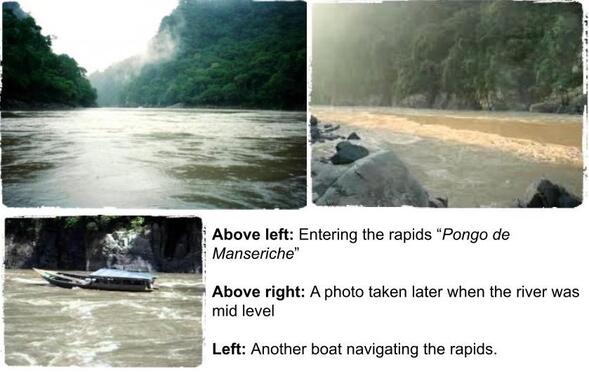
. Pongo de Manseriche
Where the Santiago river flows into the Marañon, a small lake forms before the river continues and passes through a narrow valley. The river rushes straight towards a deep and narrow gorge formed by the water over many years. It is an impressive and awe-inspiring sight. Steep rock walls rise on either side of the gorge. Trees, shrubs, and a multitude of vines hang from shelves and ledges over the river. Up to a certain height, the rocks and mountainsides look polished by the violent water masses. The water looks like it is boiling in the river. Suddenly there is a huge uprising of water where it Is being pushed up by the uneven riverbed. Then it swirls into a large whirlpool that can pull boats, cargo, and passengers to the bottom in an instant, I have heard many stories of people being lost in these rapids. There is not much danger when the water level is low, but when it is high, it is impossible to pass by boat. In fact, the military personnel in Pinglo do not allow boats to attempt the trip if the water level is above a certain level marked in the rock by the base. Today the water level was just a bit below this mark.
I was dropped off at a backwater just before the rapids. I climbed up the huge boulders, grabbed my bag and sleeping bag, and said goodbye to the teacher who had brought me this far. I continued to climb down the ridge on the large rocks along the river. When I arrived at the bottom of the rapids, there was no boat there waiting for me as I had expected! I sat down on a large rock and looked around. It was a fantastic sight! Even though it is not a long stretch of rapids, watching the violence of the water was fascinating and the noise was almost deafening. Looking up at the sides of the mountain above me, I remembered hearing about a big avalanche that had happened here a few years before. To me, it looked like it could happen again at any time. My eyes went back to the boulders at the edge of the river. I had seen something moving in the water! It was a “sungaro”, a type of huge catfish. This one looked to be close to 5 feet long and probably weighing between 100 - 120 lbs. I crawled up to a bush, cut a branch, and started whittling a spear. By the time I was finished though, the fish was gone. I sat back down on my big rock. All in all, I waited 4 hours feeling alone and a bit anxious, before finally, as it was starting to get dark, I spotted a small boat coming from downriver to pick me up. What a relief! I was very excited as I boarded and continued my journey down the river.
Where the Santiago river flows into the Marañon, a small lake forms before the river continues and passes through a narrow valley. The river rushes straight towards a deep and narrow gorge formed by the water over many years. It is an impressive and awe-inspiring sight. Steep rock walls rise on either side of the gorge. Trees, shrubs, and a multitude of vines hang from shelves and ledges over the river. Up to a certain height, the rocks and mountainsides look polished by the violent water masses. The water looks like it is boiling in the river. Suddenly there is a huge uprising of water where it Is being pushed up by the uneven riverbed. Then it swirls into a large whirlpool that can pull boats, cargo, and passengers to the bottom in an instant, I have heard many stories of people being lost in these rapids. There is not much danger when the water level is low, but when it is high, it is impossible to pass by boat. In fact, the military personnel in Pinglo do not allow boats to attempt the trip if the water level is above a certain level marked in the rock by the base. Today the water level was just a bit below this mark.
I was dropped off at a backwater just before the rapids. I climbed up the huge boulders, grabbed my bag and sleeping bag, and said goodbye to the teacher who had brought me this far. I continued to climb down the ridge on the large rocks along the river. When I arrived at the bottom of the rapids, there was no boat there waiting for me as I had expected! I sat down on a large rock and looked around. It was a fantastic sight! Even though it is not a long stretch of rapids, watching the violence of the water was fascinating and the noise was almost deafening. Looking up at the sides of the mountain above me, I remembered hearing about a big avalanche that had happened here a few years before. To me, it looked like it could happen again at any time. My eyes went back to the boulders at the edge of the river. I had seen something moving in the water! It was a “sungaro”, a type of huge catfish. This one looked to be close to 5 feet long and probably weighing between 100 - 120 lbs. I crawled up to a bush, cut a branch, and started whittling a spear. By the time I was finished though, the fish was gone. I sat back down on my big rock. All in all, I waited 4 hours feeling alone and a bit anxious, before finally, as it was starting to get dark, I spotted a small boat coming from downriver to pick me up. What a relief! I was very excited as I boarded and continued my journey down the river.
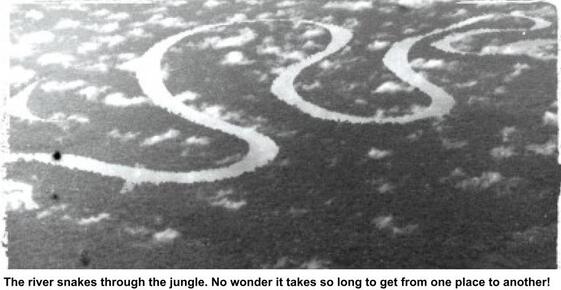
BORJA
We left the dark, narrow gorge behind, and watched the landscape open back up. We were now entering the county Loreto. Loreto is a huge, flat county and goes all the way to the border with Brasil. It is characterized by miles of jungles, intersected by rivers, but no roads. It is sparsely populated, and you can travel long distances without seeing a single house. There are small villages along the rivers, many populated by “mestizos” that are mostly descendants of the Quechua people who moved down from the mountains in times past. They primarily spoke Spanish now, although some of the elders still remembered their original language. There are also many tribal groups scattered in the jungles. Many of these groups live along the smaller tributaries and small lakes. We had not gone far when I could see a number of houses along the left bank and the small military base at the top of a hill. It was the village of Borja. There were no hotels or inns here, but arrangements were made for me to bed down in a warehouse behind a store.
We left the dark, narrow gorge behind, and watched the landscape open back up. We were now entering the county Loreto. Loreto is a huge, flat county and goes all the way to the border with Brasil. It is characterized by miles of jungles, intersected by rivers, but no roads. It is sparsely populated, and you can travel long distances without seeing a single house. There are small villages along the rivers, many populated by “mestizos” that are mostly descendants of the Quechua people who moved down from the mountains in times past. They primarily spoke Spanish now, although some of the elders still remembered their original language. There are also many tribal groups scattered in the jungles. Many of these groups live along the smaller tributaries and small lakes. We had not gone far when I could see a number of houses along the left bank and the small military base at the top of a hill. It was the village of Borja. There were no hotels or inns here, but arrangements were made for me to bed down in a warehouse behind a store.
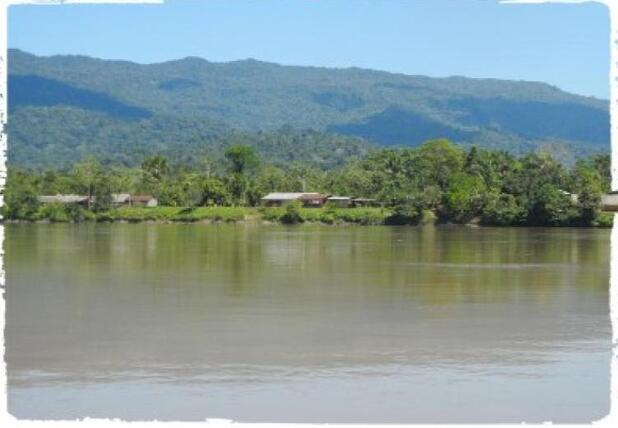
Borja had 40-50 houses and was an older village. Most of the inhabitants were, and still are mestizos, but I was told there was an Awajun village at the mouth of a small tributary a little further down the river. A Catholic Jesuit mission settled in Borja in the century after Peru was invaded by the Spaniards. But they had been gone many years. Until 1945, there had also been a large military base here. The base was pretty much in ruins now. It was a little weird to see a great bronze statue of a general standing in the middle of the forest, overgrown with greenery and surrounded by large trees as a testimony to past glories. The statue stood where the town square used to be.
Many of those I talked to, asked me to stay in Borja when they heard I was a missionary.The townspeople needed to hear the gospel, they said. I witnessed to several and felt that there was an open door here. There had been Catholic priests here for a few years, but they had left many years ago. Only the elders remembered the time when Mass was held regularly in the church. The church itself was in a miserable condition. The roof had collapsed and two walls were missing. The only thing left was a leaning statue of Christ without hands and a small Maria figure in a niche. I was told that someone tried to fix up the falling Christ statue a few years ago, but he was attacked by a swarm of wasps that had their nests inside one arm of the statue, so he had to flee. After that, no one else tried, and the jungle had grown over most of what was left. For a while, Borja had enjoyed a time of prosperity when the Mobil oil company constructed a base and storage areas here. Unfortunately, the alcohol vendors took advantage of the new prosperity, and the village was plagued by alcoholism. Now it was rumored that Mobil was moving out, so the inhabitants were worried about the future of their village.
Many of those I talked to, asked me to stay in Borja when they heard I was a missionary.The townspeople needed to hear the gospel, they said. I witnessed to several and felt that there was an open door here. There had been Catholic priests here for a few years, but they had left many years ago. Only the elders remembered the time when Mass was held regularly in the church. The church itself was in a miserable condition. The roof had collapsed and two walls were missing. The only thing left was a leaning statue of Christ without hands and a small Maria figure in a niche. I was told that someone tried to fix up the falling Christ statue a few years ago, but he was attacked by a swarm of wasps that had their nests inside one arm of the statue, so he had to flee. After that, no one else tried, and the jungle had grown over most of what was left. For a while, Borja had enjoyed a time of prosperity when the Mobil oil company constructed a base and storage areas here. Unfortunately, the alcohol vendors took advantage of the new prosperity, and the village was plagued by alcoholism. Now it was rumored that Mobil was moving out, so the inhabitants were worried about the future of their village.
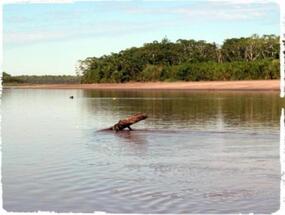
From Borja to Puerto America
The next morning I got a ride on a small boat going further down the river to continue my exploration. The owner didn’t have any fuel, so we just floated with the current. The water level had dropped and the river flowed calmer, but It still went fast enough. In some places, we went past large logs that had gotten stuck to the bottom. The man skillfully steered away from the logs and stone banks with a paddle. Just before dark, we arrived at his house, and I was invited to spend the night there. The people here are very hospitable. Having a foreigner in the house was a rare treat. There were no newspapers, and only a few people had a radio, so they enjoyed the opportunity to hear news from other places. His wife served us food, and while we ate, the family gathered around us to hear what had led me to this part of the world.
The next morning I got a ride on a small boat going further down the river to continue my exploration. The owner didn’t have any fuel, so we just floated with the current. The water level had dropped and the river flowed calmer, but It still went fast enough. In some places, we went past large logs that had gotten stuck to the bottom. The man skillfully steered away from the logs and stone banks with a paddle. Just before dark, we arrived at his house, and I was invited to spend the night there. The people here are very hospitable. Having a foreigner in the house was a rare treat. There were no newspapers, and only a few people had a radio, so they enjoyed the opportunity to hear news from other places. His wife served us food, and while we ate, the family gathered around us to hear what had led me to this part of the world.
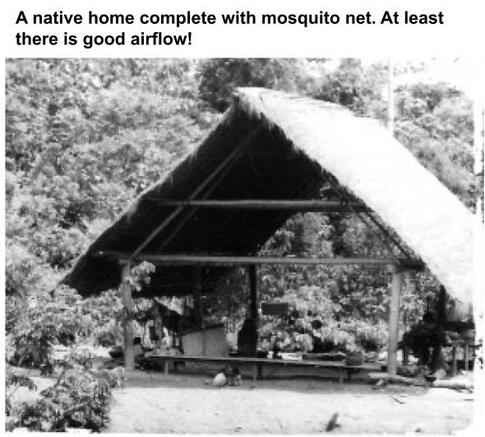
Around 6:30, a loud buzzing started all around us. The mosquitos had arrived! There is an amazing amount of mosquitos here. Of course, I had brought mosquito oil to put on me, but the mosquitos bit right through our clothes. There was only one sensible thing to do; hang up the mosquito net and get in it! After hunting for some mosquitoes that had sneaked in with me, I felt victorious as I lay there well protected and listened to the buzzing of the mosquitoes outside the net. By eight o'clock, most disappear but come back at dawn. Fortunately, there are few mosquitoes out on the river during the day, but in the shade inside the forest, they thrive around the clock! There were many other strange sounds around me as I lay in this house with almost no walls. Grasshopper and insects of all kinds made their different sounds, the frogs tuned in with an incredible volume, and a number of mammals barked in the banana field behind the house. They didn’t bother me though and surrounded by these jungle sounds and the sound of the river rushing by, I fell asleep.
I wanted to get going the next day, but the whole morning passed without a single boat passing by. Hitching a ride with passing boats is how you got around if you didn’t have your own boat. When a boat passed by you would wave from the bank with a piece of cloth, and usually, the boat would stop. If there was room, you could ride along for a small fee. Finally, at three o'clock in the afternoon, a boat came downriver and the owner responded to our waving. It was a sergeant from Pinglo who was on his way to Iquitos just over four days' journey downriver. It was an open boat, so I was glad I was not going that far. He did, however, give me a ride to the village of Puerto America which lies where the river Morona empties into the Marañon. As we got further down, the river calmed down even more and widened. The landscape was flat as a pancake. The stone banks disappeared, and here they were replaced by large sandbanks in the inner turns of the river and lots of mud. The water level was obviously fast on the way down. Puerto America seemed to be a bigger place. The name was even listed on my World Map. As darkness fell around us, I looked forward to arriving at my next destination.
I wanted to get going the next day, but the whole morning passed without a single boat passing by. Hitching a ride with passing boats is how you got around if you didn’t have your own boat. When a boat passed by you would wave from the bank with a piece of cloth, and usually, the boat would stop. If there was room, you could ride along for a small fee. Finally, at three o'clock in the afternoon, a boat came downriver and the owner responded to our waving. It was a sergeant from Pinglo who was on his way to Iquitos just over four days' journey downriver. It was an open boat, so I was glad I was not going that far. He did, however, give me a ride to the village of Puerto America which lies where the river Morona empties into the Marañon. As we got further down, the river calmed down even more and widened. The landscape was flat as a pancake. The stone banks disappeared, and here they were replaced by large sandbanks in the inner turns of the river and lots of mud. The water level was obviously fast on the way down. Puerto America seemed to be a bigger place. The name was even listed on my World Map. As darkness fell around us, I looked forward to arriving at my next destination.